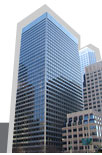Sustainable
Sites
The
Sustainable Sites category concentrates on the impact of a
building's design and exterior space.
Sustainable
Sites considers whether a building is making an effort to
reduce light pollution and the heat island effect through
its construction materials. It rewards a building for planning
and executing appropriate regional landscaping practices to
minimize the building's impact on ecosystems and waterways.
Landscaping practices should especially concentrate on controlling
storm water runoff and reducing erosion. Sustainable Sites
also focuses on the transportation practices of the occupants
in a building and encourages public modes of transportation.
- 425
Market St. surveyed more than 24% of the building's occupants
regarding their means of transportation to work. The response
of this representative sample group indicates that more
than 95% of the building population uses alternate
means of transportation other than driving alone.
- 425
Market St. utilizes drip irrigation and hand watering practices
in the maintenance of the exterior landscaping. Drip irrigation
works by applying water slowly and directly to the soil.
This system allows the water to soak into the soil and applied
where it is needed most, at the plant's roots. Besides drip
irrigation, the landscapers hand water the planters and
small areas of vegetation. Both practices help minimize
over watering and runoff.
- 425
Market St. installed a "cool roof" in 2006. A
cool roof is usually white or light in color. It is a roofing
system that can deliver high solar reflectance and high
thermal emittance. This benefits the building and the environment
in many ways.
- A
cool roof reduces the building's absorption of heat.
White reflective roofs typically increase only 10-25°F
above ambient temperature during the day. Buildings
with black roofs however can see temperature increases
as much as 50°F in the heat of a full sun.
- A
cool roof reduces both building cooling loads and the
urban heat island effect. As there is less heat-gain
by the building, the demand on the air conditioning
system lessens and allows the building both immediate
and long-term savings on energy costs.
- A
cool roof reduces air pollution and smog formation.
- A
cool roof enhances the life expectancy of the roof which
allows for savings in roof maintenance and replacement
expenses.
|

